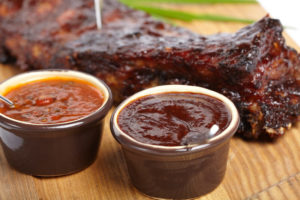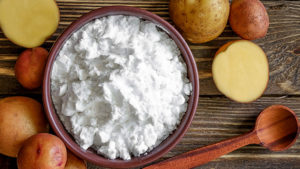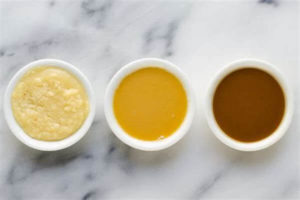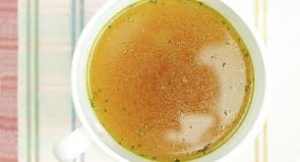Today’s article is a BBQ sauce comparison. It’s a long article and I provide a quick rundown beforehands. I’ve been writing culinary articles for a while now, and it occurred to me, that while I do my best to put all the steps into simple language that almost anyone could understand, I’m still making a few assumptions about the skill level of the reader.
 I’ve been jotting down notes while at work and while cooking at home for some time now and hopefully this series will help out those who aren’t as skilled in the kitchen.
I’ve been jotting down notes while at work and while cooking at home for some time now and hopefully this series will help out those who aren’t as skilled in the kitchen.
Once you’ve mastered the basic knife skills required to do the prep work in the kitchen, the next fundamental skill for an aspiring at-home culinarian is sauce making.
Some others would argue there are other skills that would be better utilized by a home cook, but I think the ability to make a decent sauce trumps it all. A good sauce can turn bland and even poorly cooked meat and veg into something decent.
What is a Sauce?
Definitions
So what is a sauce? I’m sure there’s slew of Frenchmen with tall hats that would like to pummel me for this simplistic definition, but at the end of the day a sauce is nothing more then a thickened flavorful liquid. That’s it. A few learned amongst you might cry “What about au jus?!” In my book, even au jus requires thickening, even if only a scant bit.
Mother May I
When talking sauces its hard to avoid the over bearing French influence that still guides the modern culinary world.
The French determined that there are five “Mother Sauces” from which all other sauces can be derived. Those being Bechamel, Espagnole (brown sauce), Hollandaise, Tomato, and Veloute.
By adding ingredients to these sauces you create the different “daughter” sauces. I’m going to tell Escoffier to fuck right off and go with my own categories of Thickened Broth, Dairy Based, Pureed, and Butter. My categories aren’t much different then the French “mother sauces” they’re just more general in their language, as well as omitting one (I’ll explain that down below)
Basics
Thickening
There are two main ways to thicken a liquid to turn it into a sauce, Reduction and Modification. Reductions are rarely used anymore simply because they take a LOT of time. You’re talking hours to prepare just one sauce. With the improving quality of bases and bouillons its no longer necessary to reduce and fortify a broth for an hour to increase the flavor. You do still see reductions in cases where very intense flavor is warranted, the most common reduction I can think of is balsamic vinegar which reduces into a very sharp, yet sweet molassesy liquid that lends massive amounts of flavor to whatever you put it on.
Modifying
The other method for thickening a sauce is Modifying. Modifying is the adding to, or altering of, your base liquid to change the viscosity. When it comes to adding something to a liquid to thicken it you’re almost always going to be looking at a starch of some kind. The most common being cornstarch or flour. Altering a liquid is the realm of the Pureed sauces, where you have a liquid with chunks of vegetable in it that you puree down to thicken. Marinara and BBQ sauce are probably the two most common pureed sauces.
Starches
While both of the main thickening starches work in the same way, they are two entirely different approaches. Cornstarch is much more convenient, being mixed on the side with cold water to form a slurry (note: “cornstarch” and “slurry” will be used interchangeably from here on out) while flour is normally** cooked with butter to form a roux (note: “flour” and “roux” will be used interchangeably from here on out) There are subtle, and not so subtle, differences between these two methods.

**Normally
There is such a thing as a quick roux. This consists of vegetable oil and flour mixed together to form a thick paste. It works just like a roux, but the quality is greatly diminished.
Boiling Point
While the two starches have different natures, they both function in identical ways. In order to activate the starch and cause it to thicken a liquid, that liquid must boil. Until you’ve reached and maintained a slow boil, you have not fully activated the starch molecules. This will be denoted, in both cases, by a starchy floury flavor and mouth feel. Roux has other aspects that play a part, which I’ll cover farther down.
The Problem With Slurry
The biggest problem you run into with slurry is that it turns whatever you add it to shiny. Its often used in desserts because of its ability to add a sheen to what its used in. That glossy look is less then desirable when it comes to meat and veg. Because of this most chefs will tell you, simply, you dont use slurry for savory sauces, but, there is a way. To remove that glossy look all you have to do is add a bit of high fat dairy, heavy cream or half and half work best. The other issue you’ll run into with slurry is that its POTENT stuff. Over thickening is always a possibility with slurry, so tread lightly. Slurry also offers a less smooth mouth feel, something important when cooking for a four star restaurant, less so when cooking at home.
Roux
Its Own Section?
Why does roux get its own section? Well, despite my attempt to pry modern culinary knowledge away from the French traditionalists, for this one item, I cannot. Roux is what it is. Its the backbone of almost all good sauces, and even a keystone in a few cuisines, the most notable being Creole. Its also a very intricate beast, with many nuances that must be understood to wield its full potential.

What Is Roux?
I said early that roux is a combination of butter and flour, and while that is an accurate description, functionally there’s a little more going on then that. To make a proper roux you need equal parts butter and flour by weight. For those of you without a scale, the ratio is roughly 1 cup of butter to just under 2 cups of flour. You melt the butter then whisk in the flour until the mixture is homogeneous. If properly made it’ll resemble Play-Doh
Raw is War
The word raw in the kitchen brings up a lot of stereotypical imagery. Uncooked steaks, diced fresh veggies, other things. One thing most people dont think about being raw is flour. Outside of baking and fried chicken, most people probably dont think about flour, period. But in the world of sauce making flour is a staple, and it is indeed raw.
You could thicken a liquid with raw flour, but if you do that you’ll find is that you can taste that raw flavor in the end result. It’ll taste like flour.
The way you solve this problem is to cook the roux. Once formed into the Play-Doh like mass just turn the heat to low and stir every 30 seconds or so. What will happen is the flour will begin to cook and toast and the roux will darken. The roux is ready in its lightest incarnation once you notice a slight golden color and a slight nutty smell. This is aptly named a blonde roux because its easy and will do almost anything you ask.
Brick House
Once you’ve achieved a blond roux you have the basic tool to thicken a sauce, but there is more that can be done. Roux can be cooked almost indefinitely, even to a point where its almost burnt, this is a brick roux. As the flour cooks and becomes darker and darker two things will happen. Firstly you’ll notice an increasingly nuttier smell filling the air. This smell directly relates to the flavor the roux will impart on your sauce.
A blond roux should add little to no flavor, where a brick roux adds a lot of flavor. The other thing that happens is the starch breaks down and the roux loses some of its thickening power. I dont have an exact number, but I would say that a blond roux has 100% thickening power, where a brick roux has roughly 75% thickening power. A good example of brick roux as a flavor component is Creole cooking.
Incorporation
There are two golden rules when incorporating roux into a liquid to be thickened, the rule of opposites and the rule of the little by little. Whatever temperature the liquid is, the roux should be opposite of that. For a simple sauce like a thicken beef stock you would melt the butter, add the flour, then cook the roux then add the cool or room temperature stock to the already hot roux, whisking quickly and constantly to avoid lumps.
For a sauce that has vegetables in it that require sautéing first, you would make your roux then set it aside to cool, cook your veggies add you liquid, bring the liquid to a boil then add in your cold roux, whisking quickly and constantly to avoid lumps.
In either case, whatever you’re adding, be it liquid to a hot roux or roux to a hot liquid, add it incrementally, dont just dump it all in. This will help prevent lumps of unincorporated roux from floating around in your sauce.
She’s Lump
Now sometimes the gods are against you in the kitchen and things do go wrong. With roux the most common problem is lumps of undissolved roux in the sauce. The easiest fix for this is simply to strain the sauce through cheese cloth or a sieve. The other options are to simply pick them out, since roux is fat and fat floats, or to keep simmering the sauce and whisking until smooth.
Gravy Defined
There is one last note in the world of flour thickened sauces, and thats gravy. So what the fuck is gravy anyways? Its a question that seems simple, but its hard to answer, for most, from an academic standpoint. The difference between gravy and all other sauces is that the fat used in the Roux is animal fat or drippings. Because of this gravies tend to be more flavorful. If you plan on making a sauce for a roasted meat dish, save that grease!
Thickened Broths
So What IS Broth?
Some of you in the know might ask whats the difference between broth and stock. In traditional culinary terms a stock is made by boiling bones of an animal, in the case of vegetables the scraps and cast off. A broth is made by boiling the meat. Now in regard to sauces, a broth will be defined as a any thin, flavorful, water based liquid that is not dairy. This can be animals stocks, fruit juice or anything else.

Which One?
So you have your broth and new knowledge of proper incorporation of the two major thickening agents, but how do you know which one to choose? Roux is universal in the savory world. I can only think of one example where you’d willingly choose Slurry over Roux, that being bolstering the thickening of a puree. If the sauce is dairy applicable then Slurry works, because as I discussed the big issue with slurry is the sheen, and dairy will dampen that.
Dairy Based Sauces
Whats the Difference?
So whats the difference between Thickened Broths and Dairy Based sauces? Its all in how you handle them. Thickening is the same, but there are rules you must adhere to when dealing with dairy because dairy products are emulsions.
Fra-gee-lay
Dairy based sauces can be very finicky. The problem with dairy, and all emulsions, is that they have the tendency to break. Breaking is when the fat separates from the water and you ostensibly begin making cheese, the wrong way. The two biggest culprits for breaking a dairy based sauce are heat and acid. While a sauce breaking doesn’t necessarily ruin it from a flavor standpoint, it does make it look really fucking unappetizing.
Duck Tape Not Applicable
Unfortunately a broken cream sauce might be the only thing duck tape cant fix, but there are ways. Now its worth saying that a broken cream sauce is usually unsalvageable. Trying to get the emulsion back is usually harder then just making a new pot. The two most common natural emulsifiers are egg yolks and mustard. Egg yolks have their own problems because you must temper them in to keep them from scrambling. Mustard, while easier, is also much more intrusive. It has a strong flavor and color that can go against the grain of the sauce you were trying to make. There are some preventive steps you can take though.
Insurance
The first thing you must know when attempting to stave off breakage is how different types of dairy react. The richer the dairy product, the less likely it is to break. Whipping cream can take acid and heat and stay together, where I’ve looked at skim milk wrong and had to come apart on me. Its also worth saying, skim milk, like white vinegar, isn’t for cooking with. Thickening the sauce before engaging in risky behavior will help keep it from breaking. Adding in roux or slurry while you warm it up and before you add in acid will help greatly. Finally, dont boil it. If your dairy based sauce is boiling its to hot, bring it to just a slow simmer to activate the thickening agent, then back down the heat.
Pureed Sauces
When to Puree
Most purees start as a broth with chunks in it, and thusly could just be strained and thickened to create a sauce that way, but when should you? It really depends on two things, what the chunks are, and what kind of sauce you want. A puree will always be a heavy hearty sauce, BBQ is a good example of a pureed sauce, and its heaviness goes well with its application. BBQ also starts with chunks of vegetable/fruit that directly enhance the flavor of the sauce. If you were making Demi Glace and cooking beef stock or brown sauce with onions, carrots and celery (mirepoix) blending those into the sauce would change the flavor from beefy, to a more vegetable flavored sauce, and that might not be what you want.
Blender Not Required
Not all pureed sauces have to be pureed in the traditional sense. A good example would be Marinara sauce. Marinara is usually a very chunky rustic sauce that isn’t alway blended, but isn’t usually modified either. Its body comes from a combination of reduction AND the breaking down (pureeing for sake of argument) of the vegetables in the sauce. As the tomatoes and other veg cook they’ll dissolve into the liquid, thickening it just like if you blended it down.

Trickery
If you’re making a pureed sauce that’ll go on a plate, slurry it, just a little. Any pureed sauce will have a bit of free moving water in it somewhere, by adding just a small amount of slurry you’ll lock up that water and the sauce wont run across the plate.
Butter Sauces
More Emulsions
Butter sauces are the tails side of the coin that dairy based sauces are on. Both rely on a stable emulsion, the difference is that a dairy based sauce is mostly water, where a butter sauce is mostly fat. The biggest difference is that with a dairy based sauce you’re maintaining an emulsion, in a butter sauce you’re creating an emulsion.
More Breakage
Just like with dairy based sauces butter sauces can break on you. The higher fat to water ratio makes them much more susceptible to it too. The one saving grace is that butter sauces tend to be less finicky when it comes to acid. The downside is that they’re very finicky when it comes to temperature. Due to butters nature of being solid at room temperature, if a sauce gets to cold it’ll seize up, if it gets to hot it’ll break.
Hold Me
So, with a butter sauce having a slim Goldilocks zone for proper holding temperature, whats the best way to hold Buerre Blanc to be used later? A thermos. Once a butter sauce is made, its made, its temperature is just where it needs to be. You dont want to add, or subtract, heat, a thermos keeps the temperature stationary better then any other apparatus.
In lieu of a thermos a plastic container with thick walls works the best. Plastic is a decent insulator and it wil help the sauce retain heat better then metal. If the sauce starts to get to cold just bring some water to a simmer and place the plastic container inside, the plastic will help slow down the heat distribution, keeping you from over heating the sauce to quickly.
Trickery
There is one secret to making and holding a butter sauce. Mustard powder. I mentioned mustard before as a natural emulsifier, but ruled it out in some cases because of its flavor and color, but with butter sauces its back on the table. Most butter sauces have a flavor and color that a small bit of mustard wont interfere with and the powdered variant of mustard is less obtrusive. You’ll rarely see mustard listed as an ingredient in a butter sauce but I recommend adding a little anytime you make Hollandaise or any other.
Repair
If you do break your butter sauce there are two things you need to fix it. Egg yolks and brute force. If a hearty application of both of those wont get it to come back together its a lost cause.
If you have any questions, feel I missed something, or want to know more about a specific topic I covered leave a comment below and I’ll get back to you. If I get a lot of comments I’ll post a Q&A response.





1 thought on “Cooking 101: BBQ Sauce Comparison”